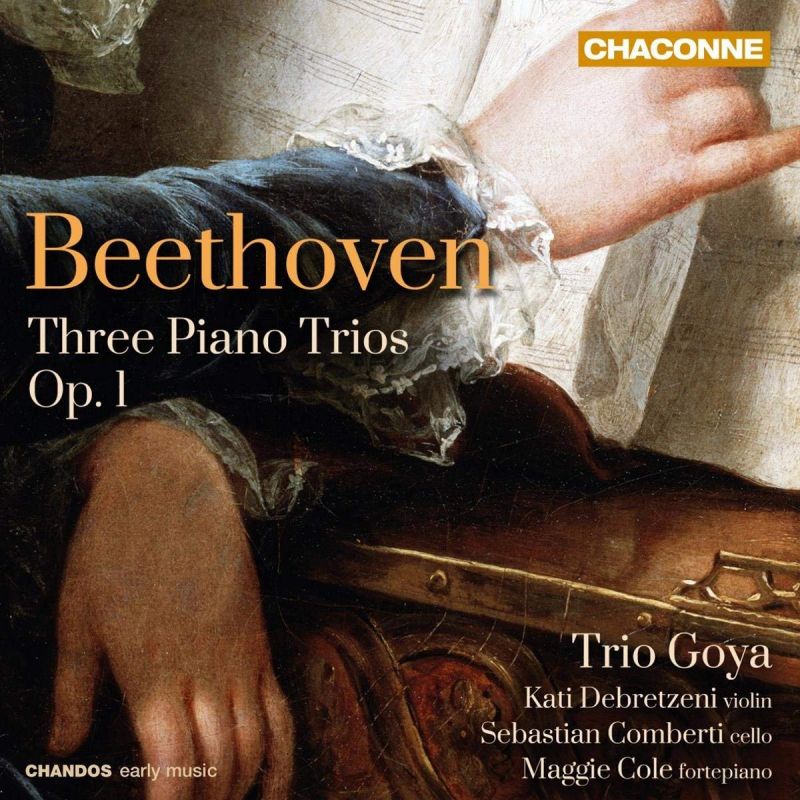BEETHOVEN Piano Trios (Trio Goya)
View record and artist detailsRecord and Artist Details
Composer or Director: Ludwig van Beethoven
Genre:
Chamber
Label: Chaconne
Magazine Review Date: AW18
Media Format: CD or Download
Media Runtime: 96
Mastering:
DDD
Catalogue Number: CHAN0822 2

Tracks:
| Composition | Artist Credit |
|---|---|
| Piano Trios, Movement: No. 1 in E flat, Op. 1/1 |
Ludwig van Beethoven, Composer
Ludwig van Beethoven, Composer Trio Goya |
| Piano Trios, Movement: No. 2 in G, Op. 1/2 |
Ludwig van Beethoven, Composer
Ludwig van Beethoven, Composer Trio Goya |
| Piano Trios, Movement: No. 3 in C minor, Op. 1/3 |
Ludwig van Beethoven, Composer
Ludwig van Beethoven, Composer Trio Goya |
Author: Andrew Farach-Colton
Take that same Trio’s Presto finale, for instance, where Cole takes the stuttering start of the main tune under tempo. Other pianists have hammed it up similarly, and it’s cute at first; but, because she plays it more or less the same way every time, it becomes increasingly irritating. Or turn to the turbulent opening Allegro con brio of the C minor Third Trio. Here, the Goya exaggerate the panting phrasing and pregnant pauses – essentially turning commas into semicolons and full stops into paragraph breaks – presumably to heighten the Sturm und Drang atmosphere. But these effects are already written into the score, and the hyperbolised interruptions simply sap the requisite brio.
When the Goya make less of a fuss, their music-making is often marvellous. In the two Scherzos, for instance, they revel in the composer’s playful brilliance: savour their giddy sforzandos in No 2, say, as well as the effervescent chatter of the running quavers in that movement’s central Trio. Cole employs a replica of a Viennese fortepiano by Anton Walter tuned using the Bach/Lehman temperament, and the instrument’s shifting colours in a modulating passage such as the development section of No 1 (start at 5'05") are exquisite. Violinist Kati Debretzeni’s playing is admirably articulate and sensitive – her surreptitious entrance at the end of No 1’s Adagio (at 6'20") is breathtaking. Sebastian Comberti is a reliable team player although somewhat too reticent, often failing to seize the opportunity to send his phrases soaring, as at 7'51" in the first movement of No 2.
If you require these works on period instruments, try the Castle Trio (Erato, 4/91, 3/92), whose forthright accounts are also a bargain. Better still, though, are the Florestan Trio, whose wise and witty interpretations (Hyperion, 6/04, 12/04) are perhaps even svelte enough to please period purists.
Discover the world's largest classical music catalogue with Presto Music.

Gramophone Digital Club
- Digital Edition
- Digital Archive
- Reviews Database
- Full website access
From £8.75 / month
Subscribe
Gramophone Full Club
- Print Edition
- Digital Edition
- Digital Archive
- Reviews Database
- Full website access
From £11.00 / month
Subscribe
If you are a library, university or other organisation that would be interested in an institutional subscription to Gramophone please click here for further information.




